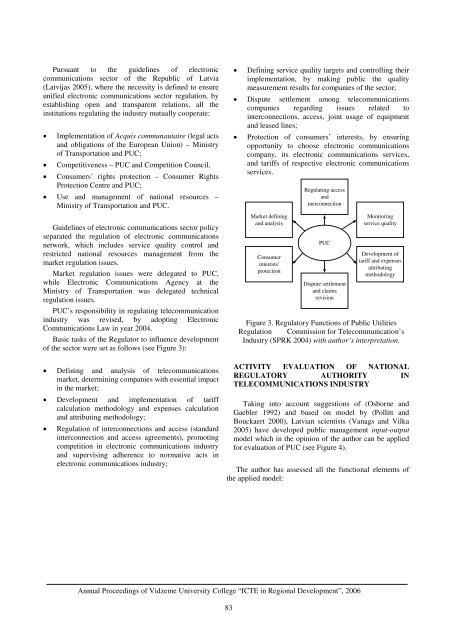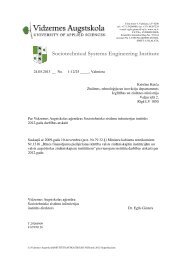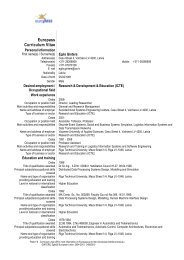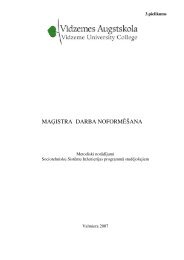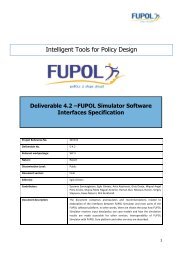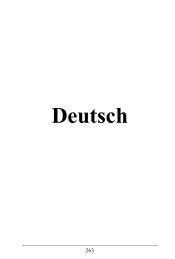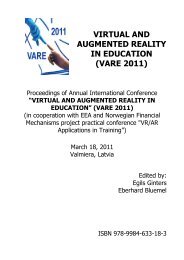Without regard to the abovementioned risks andformally apply<strong>in</strong>g asymmetrical regulation, mobiletelecommunication market will face a situation whenonly relatively cheap but low quality primitive mobiletelecommunication services will be available <strong>in</strong> Latvia,with simultaneous deterioration of social, demographic,and economic situation <strong>in</strong> the state.REGULATORY SYSTEM IN LATVIAWith adoption of Law on Regulators of PublicServices on October 19, 2000, <strong>format</strong>ion of a two-levelsystem of public service regulation was launched. Firstlevel regulator, Public Utilities Regulation Commission(PUC) was delegated a responsibility to regulate publicutilities sector on the state level, while secondary level –local municipalities – regulators were delegated aresponsibility to regulate service providers of localimportance <strong>in</strong> the territories of respective municipalities.Before the reform regulatory functions wereperformed by different <strong>in</strong>stitutions: the M<strong>in</strong>istry ofTransportation, Energy Supply Regulation Council,Telecommunications Tariff Council and RailroadAdm<strong>in</strong>istration, as well as local municipalities (SPRK2004) (see Figure 2). By tak<strong>in</strong>g over the functions of theabovementioned regulation <strong>in</strong>stitutions (exceptregulatory functions of local municipalities), a multisectorutility regulator was launched <strong>in</strong> 2001, whichsupervises energy, electronic communications, and postand railroad transportation sectors on the state level.Objectives of PUC are to protect public utilitiesconsumer <strong>in</strong>terests and promote the development ofpublic service providers. To reach this goal, NRAimplements the follow<strong>in</strong>g basic functions (SPRK 2004):• Promotes competition <strong>in</strong> regulated sectors;• Issues licences, registers General Authorizations andsupervises the adherence to their conditions;• Sets tariff calculation methodologies;• Sets tariffs <strong>in</strong> compliance with economicallyjustified expenses;• Supervises the compliance of services withrequirements for quality and safety,• Performs out-of-court settlement of disputes forcompanies of the sector;• Informs the public about the activities of publicservices providers <strong>in</strong> provid<strong>in</strong>g public utilities.When perform<strong>in</strong>g all the abovementioned functions,PUC obeys a range of key pr<strong>in</strong>ciples – all marketparticipants are ensured objectively grounded, fair andunified approach, thus ensur<strong>in</strong>g:• Uniform procedure for issu<strong>in</strong>g licences and permits;• Unified tariff calculation methodology, by sett<strong>in</strong>g”price cap”;• Openness <strong>in</strong> dispute settlement and decision mak<strong>in</strong>gprocess.REGULATION IN TELECOMMUNICATIONSINDUSTRYRegulation <strong>in</strong> the telecommunications <strong>in</strong>dustry isperformed ma<strong>in</strong>ly by the M<strong>in</strong>istry of Transportation, thefunctions of which <strong>in</strong>clude draft<strong>in</strong>g of <strong>in</strong>dustrydevelopment policy, determ<strong>in</strong>ation of general f<strong>in</strong>anc<strong>in</strong>gpr<strong>in</strong>ciples for universal telecommunications services,supervision of radio frequencies, draft<strong>in</strong>g of legislativeacts (laws and Cab<strong>in</strong>et Regulations) for the sector, andthe PUC which has been assigned all the practicalregulatory tasks. Parallel to this, telecommunications<strong>in</strong>dustry is <strong>in</strong>fluenced also by Competition Council andConsumer Rights Protection Centre with<strong>in</strong> the limits ofspecific laws under their authority.Figure 2. Regulatory Functions <strong>in</strong> the Latvia’s Telecommunication’s Industry(SPRK 2004) with author’s <strong>in</strong>terpretation.Annual <strong>Proceed<strong>in</strong>gs</strong> of Vidzeme University College “ICTE <strong>in</strong> Regional Development”, 200682
Pursuant to the guidel<strong>in</strong>es of electroniccommunications sector of the Republic of Latvia(Latvijas 2005), where the necessity is def<strong>in</strong>ed to ensureunified electronic communications sector regulation, byestablish<strong>in</strong>g open and transparent relations, all the<strong>in</strong>stitutions regulat<strong>in</strong>g the <strong>in</strong>dustry mutually cooperate:• Implementation of Acquis communautaire (legal actsand obligations of the European Union) – M<strong>in</strong>istryof Transportation and PUC;• Competitiveness – PUC and Competition Council,• Consumers’ rights protection – Consumer RightsProtection Centre and PUC;• Use and management of national resources –M<strong>in</strong>istry of Transportation and PUC.Guidel<strong>in</strong>es of electronic communications sector policyseparated the regulation of electronic communicationsnetwork, which <strong>in</strong>cludes service quality control andrestricted national resources management from themarket regulation issues.Market regulation issues were delegated to PUC,while Electronic Communications Agency at theM<strong>in</strong>istry of Transportation was delegated technicalregulation issues.PUC’s responsibility <strong>in</strong> regulat<strong>in</strong>g telecommunication<strong>in</strong>dustry was revised, by adopt<strong>in</strong>g ElectronicCommunications Law <strong>in</strong> year 2004.Basic tasks of the Regulator to <strong>in</strong>fluence developmentof the sector were set as follows (see Figure 3):• Def<strong>in</strong><strong>in</strong>g and analysis of telecommunicationsmarket, determ<strong>in</strong><strong>in</strong>g companies with essential impact<strong>in</strong> the market;• Development and implementation of tariffcalculation methodology and expenses calculationand attribut<strong>in</strong>g methodology;• Regulation of <strong>in</strong>terconnections and access (standard<strong>in</strong>terconnection and access agreements), promot<strong>in</strong>gcompetition <strong>in</strong> electronic communications <strong>in</strong>dustryand supervis<strong>in</strong>g adherence to normative acts <strong>in</strong>electronic communications <strong>in</strong>dustry;• Def<strong>in</strong><strong>in</strong>g service quality targets and controll<strong>in</strong>g theirimplementation, by mak<strong>in</strong>g public the qualitymeasurement results for companies of the sector;• Dispute settlement among telecommunicationscompanies regard<strong>in</strong>g issues related to<strong>in</strong>terconnections, access, jo<strong>in</strong>t usage of equipmentand leased l<strong>in</strong>es;• Protection of consumers’ <strong>in</strong>terests, by ensur<strong>in</strong>gopportunity to choose electronic communicationscompany, its electronic communications services,and tariffs of respective electronic communicationsservices.Market def<strong>in</strong><strong>in</strong>gand analysisConsumer<strong>in</strong>terests'protectionRegulat<strong>in</strong>g accessand<strong>in</strong>erconnectionPUCDispute settlementand claimsrevisionMonitor<strong>in</strong>gservice qualityDevelopment oftariff and expensesattribut<strong>in</strong>gmethodologyFigure 3. Regulatory Functions of Public UtilitiesRegulation Commission for Telecommunication’sIndustry (SPRK 2004) with author’s <strong>in</strong>terpretation.ACTIVITY EVALUATION OF NATIONALREGULATORY AUTHORITY INTELECOMMUNICATIONS INDUSTRYTak<strong>in</strong>g <strong>in</strong>to account suggestions of (Osborne andGaebler 1992) and based on model by (Pollitt andBouckaert 2000), Latvian scientists (Vanags and Vilka2005) have developed public management <strong>in</strong>put-outputmodel which <strong>in</strong> the op<strong>in</strong>ion of the author can be appliedfor evaluation of PUC (see Figure 4).The author has assessed all the functional elements ofthe applied model:Annual <strong>Proceed<strong>in</strong>gs</strong> of Vidzeme University College “ICTE <strong>in</strong> Regional Development”, 200683
- Page 1 and 2:
ISBN 9984-633-03-9Annual Proceeding
- Page 3 and 4:
“Development of Creative Human -
- Page 5 and 6:
TABLE OF CONTENTSINTELLIGENT SYSTEM
- Page 7 and 8:
INTELLIGENT SYSTEM FOR LEARNERS’
- Page 9 and 10:
LEARNER 1GROUP OF HUMAN AGENTSLEARN
- Page 11 and 12:
QuantityQuantityFigure 6. Distribut
- Page 13 and 14:
LEARNERStructure of theconcept mapL
- Page 15 and 16:
WEB-BASED INTELLIGENT TUTORING SYST
- Page 17 and 18:
materials to be presented and which
- Page 19 and 20:
INFORMATION TECHNOLOGIES AND E-LEAR
- Page 21 and 22:
correspondence with the course aim
- Page 23 and 24:
projects and through IT. Hence, it
- Page 25 and 26:
APPLICATION OF MODELING METHODS IN
- Page 27 and 28:
can support configuration managemen
- Page 29 and 30:
The EKD is one of the Enterprise mo
- Page 31 and 32:
CHANGES TO TRAINING AND PERSPECTIVE
- Page 33 and 34:
or an end, yet none of these attitu
- Page 35 and 36:
make decisions. It cannot be volunt
- Page 37 and 38: logs), data and video conferencing
- Page 39 and 40: Ability to follow user’s multi-ta
- Page 41 and 42: CONCLUSIONSEDUSA method gives us a
- Page 43 and 44: in successful SD. Given this situat
- Page 45 and 46: SPATIAL INFORMATIONFor the visualis
- Page 47 and 48: MOBILE TECHNOLOGIES USE IN SERVICES
- Page 49 and 50: learning environment (Learning Mana
- Page 51 and 52: ago only some curricula on Logistic
- Page 53 and 54: The Web-based version can be access
- Page 55 and 56: Web-portal, which incorporates diff
- Page 57 and 58: DO INTELLIGENT OBJECTS AUTOMATICALL
- Page 59 and 60: Table 1. Examples for introducing R
- Page 61 and 62: workable influencing of the process
- Page 63 and 64: are handed over to the objects and
- Page 65 and 66: • Basic processes, such as wareho
- Page 67 and 68: THE ECR E-COACH: A VIRTUAL COACHING
- Page 69 and 70: participating in the workshops and
- Page 71 and 72: • Assessment modules enable indiv
- Page 73 and 74: with pictures and illustrated graph
- Page 75 and 76: ECR Question Banknumber category su
- Page 77 and 78: educational programme that follows
- Page 79 and 80: DEVELOPMENT OF WEB BASED GRAVITY MO
- Page 81 and 82: These results of a model require a
- Page 83 and 84: CONCLUSIONSThe main goal of work ha
- Page 85 and 86: dimension and included within any o
- Page 87: • Resources sharing by providing
- Page 91 and 92: tariffs of regulated services have
- Page 93 and 94: INFORMATION TECHNOLOGY FOR MOTIVATI
- Page 95 and 96: difficult to predict when and for w
- Page 97 and 98: Listeners' workon the WebListenersS
- Page 99 and 100: PERSPECTIVES OF WEB PAGE AND E-MAIL
- Page 101 and 102: INCREASE IN THE NUMBER OF INTERNETU
- Page 103 and 104: tourism accommodations (home pages
- Page 105 and 106: interactive relationships with clie
- Page 107 and 108: • The data obtained by the resear
- Page 109 and 110: Central Statistical Bureau of Latvi
- Page 111 and 112: departures for 1995 are taken from
- Page 113 and 114: 120100maximumworldminimum806040200-
- Page 115 and 116: 140120maximumworldminimum1008060402
- Page 117 and 118: would be a promising extension. Cur
- Page 119 and 120: AN OVERVIEW OF THE AGENT − BASED
- Page 121 and 122: Suitability for social system simul
- Page 123 and 124: 6. MASONDescription:MASON is a fast
- Page 125 and 126: Suitability for social system simul
- Page 127 and 128: could be bad particularly when over
- Page 129 and 130: (for 10 repeat &| CCar[]->runfor);P
- Page 131 and 132: • Streaming audio• Collaboratio
- Page 133 and 134: NECESSITY OF NEW LAYERED APPROACH T
- Page 135 and 136: Up to now, there has only been limi
- Page 137 and 138: aaaaa6= −aa2,1 = − a0,3226= −
- Page 139 and 140:
∂ u∂x∂ u∂y2 2+ b = 02 2wher
- Page 141 and 142:
a6,3= −2030a4,5−130a4,3- - - -
- Page 143 and 144:
0,10,20,30,4( )Mag x y y Ge wx2, =
- Page 145 and 146:
Example 1. To understand better the
- Page 147 and 148:
Therefore, further the following co
- Page 149 and 150:
SOLUTION OF THE THREE-DIMENSIONALEQ
- Page 151 and 152:
Mag1, m , m , m1 2 3= mm1 m2m32 2 2
- Page 153 and 154:
MagMag0, m , m , m1 2 31, m , m , m
- Page 155:
CONCLUSIONSThe basic content of thi


